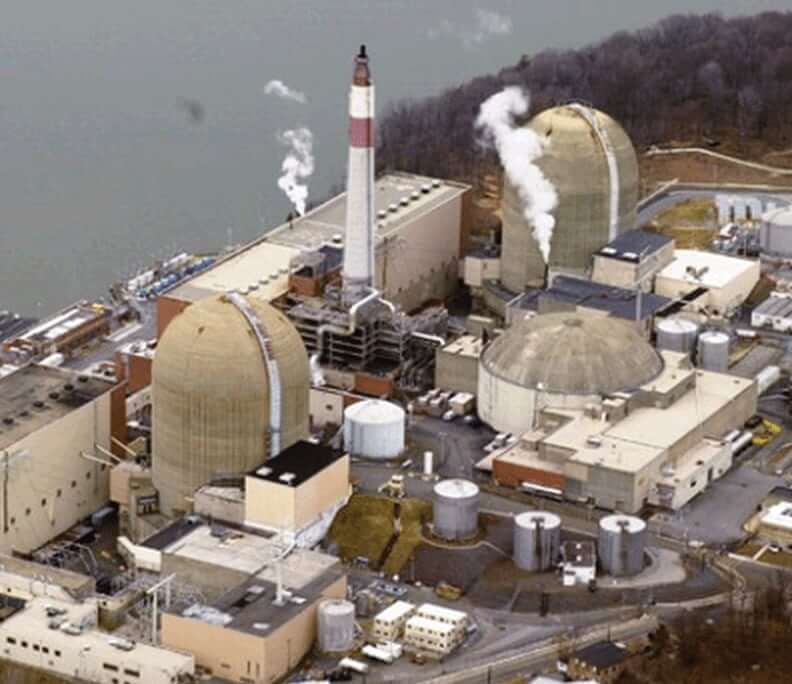Indian Point Closure At Odds With Wind Plan

Governor Andrew Cuomo announced with great fanfare in January that he intends to make New York State a leader in the march toward clean energy by encouraging the construction of a network of offshore wind turbines.
Cuomo released a comprehensive New York State Offshore Wind Master Plan which he said provided guidelines to the cost-effective development of 2.4 gigawatts of offshore wind by 2030, enough to power up to 1.2 million homes with clean energy.
Just a year earlier, also to much fanfare, Cuomo announced he had brokered a deal to shut the Indian Point Nuclear Plant, in Buchanan, NY by 2021. What Cuomo neglected to mention was a significant amount of power would be needed to replace Indian Point, and it would come, for the most part, from fossil fuel burning conventional power plants, along with the corresponding harmful emissions.
“He minimized the effects the closure would have on the power grid, electric bills, workers, and the regional economy,” according to the New York Times.
After praise from clean energy advocates and environmental groups, the realization is setting in: the wind-generated power industry is ill-equipped to produce the electricity needed to meet the governor’s goals, and it is wishful thinking that it will eliminate the need for fossil fuel or significantly reduce harmful emissions.
Further, wind energy generating companies have deliberately misled the public into believing wind energy replaces fossil-fuel burning energy: the two co-exist and interact. “We are all on one large grid. There’s always a need for a generation plant. It’s a mix,” acknowledged Sid Nathan, LIPA’s chief of staff.
Cuomo wants Indian Point closed because he says it is a potential terrorist target only 30 miles away from New York City. But it supplies about 25 percent of the electricity for New York City and Westchester County, and nuclear energy is the cleanest on the market by far.
To replace it, Cuomo, despite his ambitious wind-energy agenda for New York’s future, is turning to other energy sources for the here and now. Independent power company Advanced Power has secured financing and begun construction on its 1100-megawatt Cricket Valley Energy Center in Dover, New York. It will be fired by natural gas.
State officials have discussed augmenting the power generated by Cricket Valley by contracting with the Champlain Hudson Power Express power company in Canada, which could deliver hydroelectric power once it is completed. The target date is 2021, but some critics are complaining about using an international competitor.
Phil Wilcox is a representative for the International Brotherhood of Electrical Workers Local Union 97, a union which represents nearly 5000 workers at utilities like National Grid, said the Champlain Hudson line will “kill” incentives for future investment in the state’s generation and transmission system by essentially ignoring — and compounding — the upstate congestion issue.
“Thousands of existing New York state jobs will be lost and thousands of potential new ones as well,” Wilcox said.
Though Cuomo is talking about building hundreds of wind turbines, the only project even remotely close to becoming a reality is Deepwater Wind’s modest 15-unit farm off the coast of Montauk — and it is mired in controversy.
Meanwhile, fossil fueled power plants continue to be planned and built in the state. The Wawayanda 680-megawatt power plant is under construction 65 miles (105km) northwest of New York City. The power plant will cover an area of 21.25 acres on a 122-acre Greenfield site. The combustion turbine stacks at the site will be approximately 275 feet high.
Nearby residents are already raising air quality concerns as the controversial natural gas power plant begins testing its smoke stacks. They say there is a strong, diesel-like fuel odor that can be smelled for miles coming from the Wawayanda power plant. “The realization was this isn’t smog. We’re just standing in pollution,” Chris Kehoe, a local resident, told News 12.
Closer to home, the Caithness Long Island II project was selected by the Long Island Power Authority in July 2013 to build new on-island generation to meet the region’s growing energy needs, and to reduce its reliance on Long Island’s aging fleet of power plants. Caithness Long Island II will be a highly efficient 750-MW natural-gas-fired, combined-cycle electric generating plant that uses air-cooled technology,” according to a company press release. It will be located in Yaphank.
Caithness I, in Yaphank, is a 350-MW natural gas fueled facility, “which is currently Long Island’s cleanest, most efficient and water conserving base load power plant,” according to the company.
All of this construction of fossil fuel driven plants fly in the face of Governor Cuomo’s vision a huge offshore wind farm presence that will solve the state’s energy problems with clean energy. Critics contend Cuomo is using the Clean Energy tag for political reasons, possibly a run at the U.S. presidency.
Closer to home, where East Hampton is vying to become the first location in New York State to receive power from an offshore wind farm, whether it is even needed has become a hot topic. One weak substation in the town makes it vulnerable during peak power times, and the substation could easily be replaced. In fact, LIPA has quietly made plans to do so, fueling it with power from the west via a yet-to-be-built underground cable. The cable could also theoretically carry power, including wind generated power, to the west. That story is reported elsewhere in this section.
rmurphy@indyeastend.com



